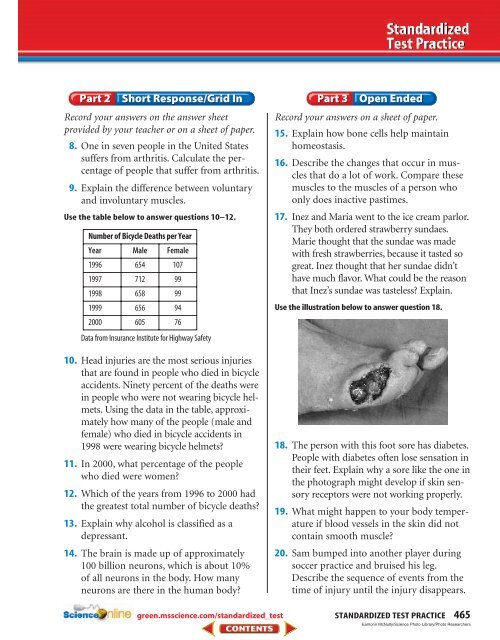Chapter 15: Support, Movement, and Responses - Science
Chapter 15: Support, Movement, and Responses - Science
Chapter 15: Support, Movement, and Responses - Science
Create successful ePaper yourself
Turn your PDF publications into a flip-book with our unique Google optimized e-Paper software.
Record your answers on the answer sheet<br />
provided by your teacher or on a sheet of paper.<br />
8. One in seven people in the United States<br />
suffers from arthritis. Calculate the percentage<br />
of people that suffer from arthritis.<br />
9. Explain the difference between voluntary<br />
<strong>and</strong> involuntary muscles.<br />
Use the table below to answer questions 10–12.<br />
Number of Bicycle Deaths per Year<br />
Year Male Female<br />
1996 654 107<br />
1997 712 99<br />
1998 658 99<br />
1999 656 94<br />
2000 605 76<br />
Data from Insurance Institute for Highway Safety<br />
10. Head injuries are the most serious injuries<br />
that are found in people who died in bicycle<br />
accidents. Ninety percent of the deaths were<br />
in people who were not wearing bicycle helmets.<br />
Using the data in the table, approximately<br />
how many of the people (male <strong>and</strong><br />
female) who died in bicycle accidents in<br />
1998 were wearing bicycle helmets?<br />
11. In 2000, what percentage of the people<br />
who died were women?<br />
12. Which of the years from 1996 to 2000 had<br />
the greatest total number of bicycle deaths?<br />
13. Explain why alcohol is classified as a<br />
depressant.<br />
14. The brain is made up of approximately<br />
100 billion neurons, which is about 10%<br />
of all neurons in the body. How many<br />
neurons are there in the human body?<br />
green.msscience.com/st<strong>and</strong>ardized_test<br />
Record your answers on a sheet of paper.<br />
<strong>15</strong>. Explain how bone cells help maintain<br />
homeostasis.<br />
16. Describe the changes that occur in muscles<br />
that do a lot of work. Compare these<br />
muscles to the muscles of a person who<br />
only does inactive pastimes.<br />
17. Inez <strong>and</strong> Maria went to the ice cream parlor.<br />
They both ordered strawberry sundaes.<br />
Marie thought that the sundae was made<br />
with fresh strawberries, because it tasted so<br />
great. Inez thought that her sundae didn’t<br />
have much flavor. What could be the reason<br />
that Inez’s sundae was tasteless? Explain.<br />
Use the illustration below to answer question 18.<br />
18. The person with this foot sore has diabetes.<br />
People with diabetes often lose sensation in<br />
their feet. Explain why a sore like the one in<br />
the photograph might develop if skin sensory<br />
receptors were not working properly.<br />
19. What might happen to your body temperature<br />
if blood vessels in the skin did not<br />
contain smooth muscle?<br />
20. Sam bumped into another player during<br />
soccer practice <strong>and</strong> bruised his leg.<br />
Describe the sequence of events from the<br />
time of injury until the injury disappears.<br />
STANDARDIZED TEST PRACTICE 465<br />
Eamonn McNulty/<strong>Science</strong> Photo Library/Photo Researchers
















